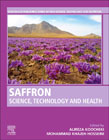
Saffron: Science, Technology and Health
Koocheki, Alireza
Khajeh-Hosseini, Mohammad
Saffron: Science, Technology and Health summarizes the scientific, technical and health aspects of this crop. Saffron possesses unique agronomical, ecological, social and physiological characteristics. And, there are various chemical components present in saffron, including carbohydrates, minerals, vitamins, color pigment, aromatic and flavoring agents. Saffron has a long history of use in traditional medicine, and in recent years, the application of saffron in the medical industry as a cancer curing and antidepressant agent has brought more attention. There is also a growing trend of saffron use in the conventional food industry, including saffron desserts, cream, butter, beverages, powders, cake mixes and soups. Intended for nutrition scientists and scientists and technologists working in the areas of food, agriculture, new product development and pharmacology. Summarizes the scientific, technical and health aspects of saffronExplores the use of saffron in the conventional food industry in the development of new productsUncovers the unique agronomical, ecological, social and physiological characteristics of saffron INDICE: Section One: Cultural and Social Aspects of Saffron 1. Saffron and Folklore 2. Saffron and Religions 3. Saffron in the Ancient History of Iran Section Two: Saffron Production 4. Evolution, Botanical and Agricultural Characteristics of Saffron (Crocus sativus L.) and Related Species 5. Soil Conditions for Sustainable Saffron Production 6. Water Requirement of Saffron 7. Saffron Seeds- The Corm 8. Advances in Modeling Saffron Growth and Development at Different Scales 9. Saffron Crop Protection 10. Ecophysiology of Saffron 11. Emerging Innovation in Saffron Section Three: Genetics and Biotechnology of Saffron 12. Molecular Biology and Genetics of Crocus sativus L. 13. Tissue and Cell Culture of Saffron 14. Secondary Metabolites in Saffron Section Four: Saffron Processing 15. Dehydration of Saffron Stigmas 16. Assessment and Monitoring of Saffron Microbiological Criteria 17. Saffron Adulteration Section Five: Economy and Trade of Saffron 18. Saffron Cultivation: An Economic Analysis 19. Saffron Marketing: Challenges and Opportunities 20. Environmental-Economic Analysis of Saffron Production with the Emphasis of Energy, Environmental Impacts and Ecosystem Functions Section Six: Saffron and Health 21. History of Saffron in Medicine 22. Phytochemistry of Saffron 23. Saffron in Traditional Medicine 24. The Effectiveness of Saffron (Crocus sativus L.) on Memory Function, Learning Ability and Epilepsy 25. Antidepressant and Antianxiety Properties of Saffron 26. Saffron (Crocus sativus L.) and its Constituents; their Anti-Inflammatory and Immunomodulatory Effects 27. Cardiovascular Effects of Saffron and its Active Constituents 28. Saffron (Crocus sativus L.) and its Main Constituents, their Effect on Respiratory System 29. Saffron in Metabolic Disorders 30. Available Saffron Formulations and Patents
- ISBN: 978-0-12-818638-1
- Editorial: Woodhead Publishing
- Encuadernacion: Rústica
- Páginas: 580
- Fecha Publicación: 17/01/2020
- Nº Volúmenes: 1
- Idioma: Inglés
